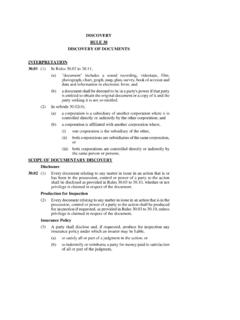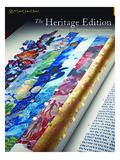Transcription of Table of Contents - Prince Edward Island
1 Ta b l e o f C o n t e n t s Introduction 2. Styles 3. Roofs 15. Eaves and Gables 17. Dormers 19. Framing 21. Masonry 25. Wood cladding 27. Doors 30. Windows 32. Resources 36. Glossary 38. Built Heritage Research Guide 40. Printed Sources 41. Web Sites 43. Architectural Drawings and Plans 44. Insurance Minutes and Plans 45. City of Charlottetown Records (PARO, 20) 46. Business and Telephone Directories 46. Genealogical Sources 46. Maps 46. Aerial Photographs 46. Cadastral Maps / Atlases 47. Land Conveyances 47. Photograph Collections 47. Community Histories 47. General References 47. Recognition of Heritage Places 48. Prince Edward Island Register of Heritage Places Application 49. Prince Edward Island Register of Heritage Places Guidelines 53. Front cover : Victoria Village Inn, 1870 by Henry Dunsmore, 2006 Island Art Collection Introduction A building doesn't have to be a stately H. mansion or quaint farmhouse to be historic and worth preserving.
2 According E. to the standards of many heritage and preservation bodies, any building over R. 50 years old qualifies for consideration as a heritage property. For instance, I. if a bungalow built in the 1950s isn't already considered a heritage building, T. it soon will be. If this seems absurd, note that many of the buildings we now A. regard as priceless heritage houses were considered commonplace and ordinary G. at the time they were built. E. Prince Edward Island has a rich variety I can remember how little we of buildings from all eras of its history. Individually, many of them are excellent had. My God! The old house we lived in, you had to go H. examples of a particular style of architecture. Their styles reflect a wide through a little door to get in and my father and mother had O. range of factors personal taste, general popularity, economic prosperity and the to go through our room to get in their little room. A small U. availability of technology.
3 Little house knots on the floor that you'd trip over. S. They do more than remind us of our past; they are a priceless element in our Tommy Duncan, b. 1900 E. landscape, both urban and rural. They are also a fragile part of our landscape, easily damaged or destroyed by uncaring N. or uninformed repairs and renovations. O. These notes aren't intended to be a how- to manual for restoring your old house T. or a design guide to historic architecture on Prince Edward Island ; instead, they E. hope to give an introduction to the elements that make up an old house and S. how they have evolved over the last two centuries. 2 . S. T. Y. L. E. S. Georgian Late 1700s to 1840s Georgian style buildings are simple rectangular blocks with carefully balanced facades. Door and window openings on the facade are always in odd numbers (3, 5, 7), symmetrically located and evenly spaced. The door is central, often with sidelights and transom panels. The porch is often a simple overhang or portico large enough to provide an airlock.
4 Windows are arranged symmetrically, two on each side of the door. Second storey windows are directly above the door and windows below. Georgian houses sometimes had hip roofs, but usually the roof is gable style with a low pitch. Either style of roof will have a minimal overhang. Dormers will be gable style. 3 . S. T. Y. L. E. S. Greek Revival 1800 to 1880s The Greek Revival style is a more dramatic exploration of the principles of symmetry and detail established by Georgian architecture. Based on the proportions of Greek temples, the style was very popular for banks, but the form was easily adapted to houses, ranging from simple farmsteads to formal mansions. The door is usually central, with sidelights and transom windows. The porch usually dominates the facade, often with a pedimented roof, columns and pilasters. Windows are arranged symmetrically, two on each side of the door. Second-storey windows are directly above the porch and windows below.
5 Greek Revival houses usually have gable roofs with a low pitch, wide overhang and returned eaves. Wide corner boards suggest the gable end of the house is supported by columns. Dormers are rare, but if present will usually have gabled roofs with eave returns to reflect the main roof style. 4 . S. T. Y. L. E. S. Gothic Revival 1830s to 1880s The Gothic Revival style emerged as a rebellion against the formality of Georgian and Greek Revival architecture. Based on the proportions of Medieval cathedrals, the Gothic Revival style emphasized verticality seeking to draw the eye upwards. Doors can be either central or offset to one side of the facade. They often have pointed panels or windows and a pointed or hooded lintel. The porch is often a verandah spanning the full width of the facade. Windows often have a pointed top sash or a hooded cap. Second storey windows are above those below and the center gable features a large window in the center and often a smaller one at the peak.
6 Gothic Revival houses have steeply-pitched gable roofs with a centre gable and an abundance of decorative woodwork. Dormers are rare. 5 . S. T. Y. L. E. S. Italianate 1850s to 1890s Like the Gothic Revival, the Italianate style was a rebellion against the formality of the more formal Georgian and Greek Revival styles. It used rambling, informal Italian villas as a model. Doors are usually centrally located, sometimes with sidelights and transom window. The porch is sometimes a verandah that wraps around the front and side facades, but can also be an overhang with an upper storey to suggest a tower. Windows are usually tall and narrow, topped with an arched cap or a rounded hood. Italianate houses have a flat or, more commonly, a low-pitched hip roof with wide overhangs supported by elaborate brackets. Dormers are rare, usually replaced by a square cupola. 6 . S. T. Y. L. E. S. Romanesque 1870s to early 1900s The emphasis in the Romanesque style is on width, rather than height.
7 The facade usually features a variety of pattern, texture and decorative woodwork. Doors are usually offset and only rarely feature sidelights or transom. If the door itself isn't arched, the door frame often is. Porches, if present, are usually under a rounded arch. Windows are randomly located, sometimes with arched sashes or under a hooded sill. The roof on a Romanesque house is broad to emphasize the overall horizontal lines of the house. They are gambrel, gable or a blend of both. A common feature on Prince Edward Island is a snub gable combined with a centre-cross gable, as seen here. Dormers are sometimes set above a two-storey bay to suggest a tower. 7 . S. T. Y. L. E. S. Mansard 1870s to early 1900s Sometimes called Second Empire, the Mansard style was named for the designer of its distinctive roof, Fran ois Mansard. The height of the roof, combined with dormers, provided a full upper storey of usable space. For this reason, the style became popular for remodeling projects during its era.
8 The style was often combined with Italianate. Doors can be either central or offset. The porch can be part of an Italianate-style verandah, the first storey of a projecting front tower or, as seen here, a simple, offset airlock. Windows are often grouped in bays or towers, if an asymmetrical facade is desired. All emphasis in a Mansard Style house is on the roof. A very steep lower pitch, often with a gentle inward curve, is capped with a flat or slightly-pitched hip roof. Dormers sometimes have roofs reflecting the main roof style, but frequently feature shapes borrowed from other styles. Cupolas are often present if the design doesn't feature a front tower. 8 . S. T. Y. L. E. S. Queen Anne 1880s to early 1900s The Queen Anne style emphasizes asymmetry and intricate ornamentation. The facade usually incorporates a variety of decorative wood and shingle work. Almost all are unique. Doors are usually offset and often decorated with irregularly placed inserts and multi-paned, sometimes leaded, windows.
9 May be paired or single. Porches can be part of a tower, extend into a verandah, capped by a portico or all of the above! Windows are irregularly placed and often incorporate coloured glass. Queen Anne style houses usually have a blend of hip and gable roofs. A tower, turrets and dormers are often featured. The style was popular during the silver fox boom of the early 1900s and wealthy fox farmers often celebrated their prosperity by building a new house in the Queen Anne style. As a result, these houses are often nicknamed Fox Houses.. 9 . S. T. Y. L. E. S. Vernacular Island Ell 1870s to early 1900s Most of the houses on Prince Edward Island were not designed by architects or built from plans. They were fashioned by carpenters who simply built the kind of houses they knew how to build. These adaptations are formally referred to as vernacular styles. They were often based on formal architectural styles, and like them, can be associated with certain decades.
10 Taking its nickname from its L-shaped floor plan, the Island Ell is the classic Prince Edward Island farmhouse. The door to the main house was usually offset the door to the wing was usually sheltered under a verandah tucked between the wing and the main house. Later renovations often turned the verandah into a sun porch. Windows are sometimes set in a bay (sometimes a two-storey bay) or sometimes in symmetry with the door. Gables and eaves were sometimes dressed with brackets and ornamental shingle work. The roofs on an Island Ell are gable with a steep pitch. Dormers are rare, but the wing often features a centre gable. 10 . S. T. Y. L. E. S. Vernacular Centre Dormer early 1800s to 1840s This simple design, built around a central chimney, was very common in the Prince Edward Island countryside in the first half of the 1800s. You can see how it was based on the more formal Georgian style. 11 . S. T. Y. L. E. S. Vernacular Centre Gable 1840s to early 1900s Larger and roomier than the Centre Dormer style, Centre Gable houses became quite popular in the mid-1800s.

















